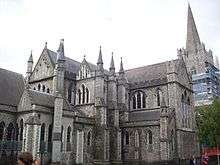John de Karlell
John de Karlell (died 1393) was an English-born cleric and judge in fourteenth-century Ireland. He became Chancellor of St Patrick's Cathedral, Dublin, after a struggle to gain the office against his fellow judge Walter de Brugge.[1]
Biography
He took his family name from his birthplace, Carlisle, Cumbria; he was the brother of William de Karlell, whose career paralleled his own.[2] Disparaging remarks made by their political opponents about William's "low station in life" suggest that the brothers came from a relatively humble background, a subject on which they are known to have been sensitive. William arrived in Ireland in the entourage of the King's second son Lionel of Antwerp, the Lord Lieutenant of Ireland, in 1361; John may have arrived at the same time, though little is heard of him until after 1370.[3]
Both brothers sat in the Irish House of Commons as members for Kilkenny City in the Parliament of 1374 and both served as Barons of the Court of Exchequer (Ireland). They were hard-working Crown officials with wide-ranging duties, and both were well rewarded for their services: John was given a licence to export wheat to France and Portugal, and to "levy profits" while absent from Ireland. He acted as papal collector of taxes in 1381.[4]
Like many clerics of the time he was something of a pluralist: he was prebendary of Ferns and Limerick, and became parish priest of Culfeightrin, County Antrim in 1389.[5]
In 1376 he was nominated as Chancellor of St Patrick's Cathedral, but he had a strong rival for the office in Walter de Brugge.[6] Walter had a very similar background to John, being a fellow Baron of the Exchequer and also a clergyman noted for pluralism; like John he was in royal service, being a close associate of Lionel of Antwerp's son-in-law Edmund Mortimer, 3rd Earl of March. In 1377 de Brugge petitioned the Privy Council asking them to examine the evidence and pleading for justice to be done to him. His plea was unsuccessful and Karlell was confirmed as Chancellor in December 1377.[7]

At his death, despite his long association with St Patrick's Cathedral, he chose to be buried close to his brother William in St Canice's Cathedral, Kilkenny. His tomb has long since been destroyed.[8]
References
- Ball, F. Elrington The Judges in Ireland 1221-1921 John Murray London 1926 Vol. 1 p. 167
- Ball p.167
- Ball p.167
- Ball p.167
- Ball p.167
- National Archives SC 8/213/10619
- National Archives
- Ball p.167